|
|
Post by JohnH on Feb 21, 2014 22:30:56 GMT -5
Bass cut and G&L ‘PTB’ wiring
This is an interesting one, which I have not tried myself.
Whereas a normal tone control (be it standard, TBX, No-load or Grease-bucket) works by bleeding treble from hot to ground, under the control of pots and caps, the passive bass-cut circuits sometimes seen in guitars work by feeding the signal from pickup to the hot side of the volume pot, via a very small capacitor that chokes off the low frequencies. This acts with the resistance of the volume pot to make a high-pass RC filter. so the volume pot is also a key part of the system. The bass-cut cap is bypassed by a pot, usually a high value, and when fully bypassed the control has no effect. That is a good feature, we can have this control with no loss of other available tones.
I think G&L are the most noted manufacturer to include a bass-cut control as standard, together with a normal treble control. They called this the PTB system, for Passive Treble and bass. Here is the schematic of the G&L PTB tone control:
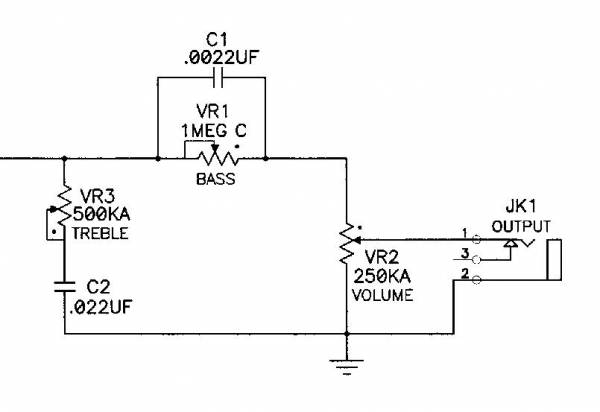
This versatile set-up seems to generate some enthusiasm!:
two-band-ptb-tone-control-useful-easy-cheap-awesome
The PTB system is shown with a higher value tone pot of 500k, and there does seem to be advantages in doing that, maintaining a 250k volume pot to act as part of the bass-cut circuit. They also use a 1M anti-log bass pot, so that, as with treble cut controls, minimum cut can be the fully clockwise '10' position. But it could be a normal log pot if the user gets accustomed to it, or a linear pot. For the modelling below, I used a 1M linear pot, just to see what happens.
Bass Cut - effect of the pot
Using a single coil pickup, and G&L's standard pot and cap values (but with linear pot), here is the response, all at max except the bass pot:
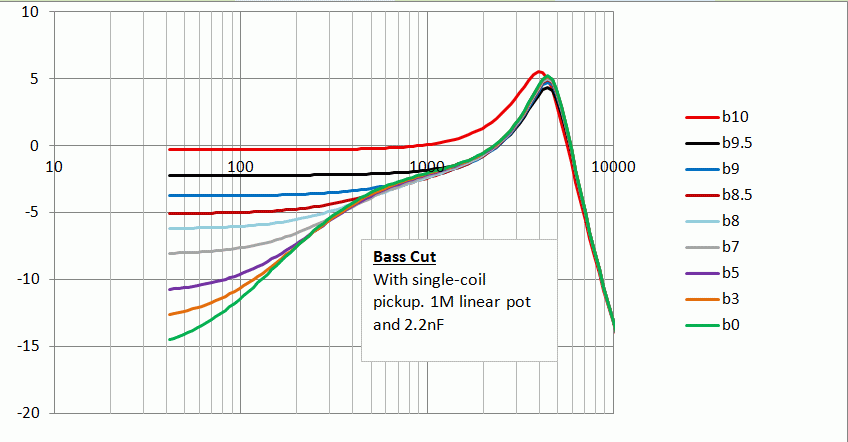
The plots go down to 40Hz, in case this is put in a bass guitar. The traces are in half-step increments, then 1 then 2 then 3 steps. This does seem to confirm that in fact, a log or anti-log taper is most suitable.
Also, you can see how the slope of the bass fall-off is fairly constant in all settings, but reaches a lower plateau dependent on the pot setting and the cap. So at the maximum extent of bass cut, the only extra bass cut is to the very lowest frequencies, while at higher pot settings, the transition is at a higher frequency. Very small amounts of bass cut actually cut most of the spectrum, possibly leaving just the peak intact.
Bass cut - effect of the cap
Stepping through a range of bass-cut cap values, we get this:
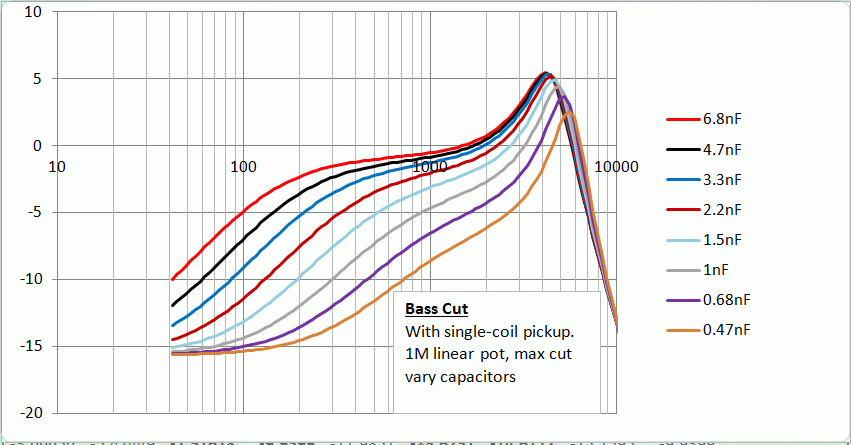
I think, for use with the other components selected, the 2.2nF seems like a good general value, but others who have tried such systems would have a more informed view. it's also interesting to note how, with very small cap values, the cutting is starting to carve away at the low-frequency side of the high peak, pushing the peak frequency higher - to be discussed further...
The PTB system - bass and treble control
Adjusting both tone controls of the full PTB system would give a lot of options. Here is a range of plots, with treble at maximum (10), mid (5) or minimum(0), with bass at max, min, or, about midway through the response which seems to be at around 8 on the linear pot modelled:
![]()
So this system seems like a pretty versatile set up, and doesn't take away from the standard tones.
|
|
|
|
Post by JohnH on Feb 21, 2014 23:17:40 GMT -5
Using PTB to make a humbucker sound more like a single coil?
This post is speculative, based on looking at the results from the post above.
Suppose we had a guitar with a PTB system, and a humbucker pickup. To what extent could the tone control system be used to make it sound more like a single coil? From the electrical standpoint, maybe quite a lot:
Here is a plot of a single coil (blue) and a humbucker (red). Of course, the Hb is really louder than the SC, but just look at the shape of the tones:
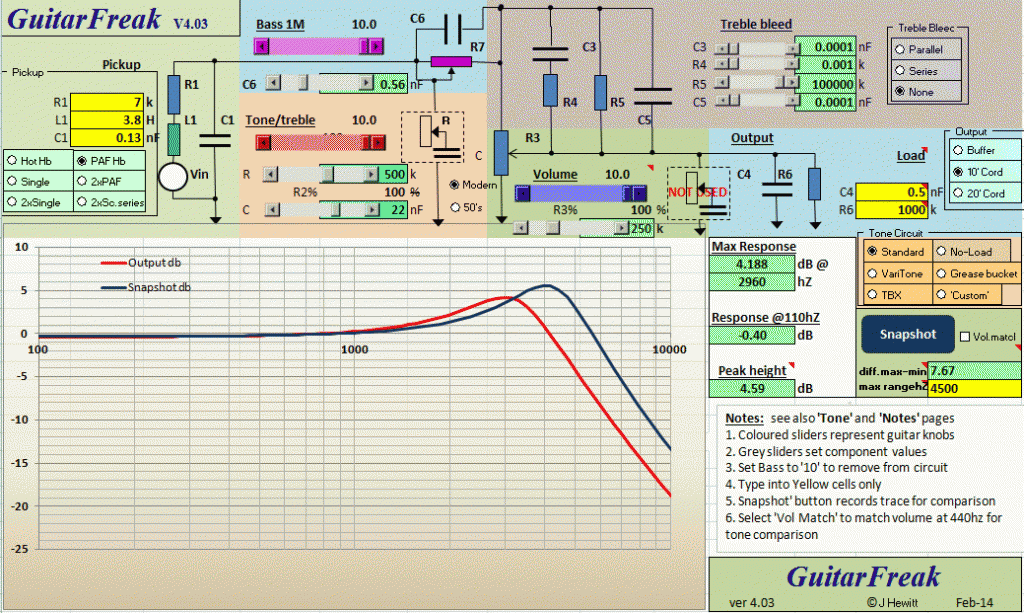
The PTB controls have been set up with a very small bass-cut cap of 0.56nF (chosen after some fiddling about with the spreadsheet). Bringing in some of the bass cut lowers the response and shifts the peak:
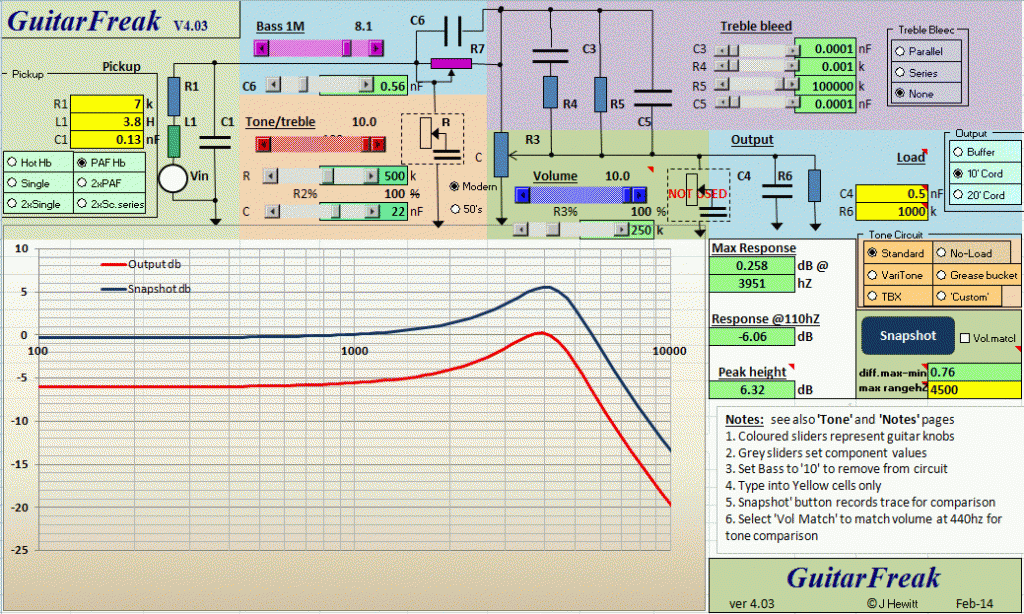
We now have two parallel traces, ie, the humbucker, adjusted by the tweaked PTB, is giving a very similar tonal relationship to the SC that it is trying to imitate. It's about 6db lower, which is pretty much what half a humbucker would normally provide, except that we are still using two coils and it is still noise cancelling.
Here are the two traces matched in volume so you can really see how close it is:

Numerically, the tonal range (being the max plus min differences between traces at all frequencies up to 4.5khz) is just 0.76db, or +/-0.38db
So, there's an idea! Maybe another way to get SC-like tones from humbuckers, to go with coil cutting and parallel wiring. If this was done with a narrow type of HB (to get a similar sensing area as an sc), such as a rails or SC sized humbucker, it might be a convincing noise-cancelling single coil alternative.
Maybe?
|
|
|
|
Post by ashcatlt on Feb 22, 2014 1:08:00 GMT -5
Whereas a normal tone control (be it standard, TBX, No-load or Grease-bucket) works by bleeding treble from hot to ground... John, this is all great stuff of course! I have trouble with this part, though. It implies that idea that ground is some destination point, and that hot and ground are somehow distinct entities. It's a bit more correct to say that the high frequencies are short circuited. It is a circuit, after all, like a circle, everything trying to get back around to where it started from. Instead of taking the "long way" through the 1M of the amp input, the higher frequencies get to take a short cut through the cap. But the right answer, of course, is that "everything useful is a voltage divider". This is a fairly complex one, so to make sense of it, you either have to break it down or just sim up. I'm not up to outlining it in anywhere near a well reasoned and documented fashion as you've done above. It is, though, all about voltage division. The impedance of the (inductive and resistive) pickup at a particular frequency is the "top resistor" and the series impedance of the tone rheostat (not pot  ) through the capacitor in parallel with whatever else hangs off the end (V pot, cable, amp input) is the "bottom resistor". For high frequencies, the Z of the pickup gets very large compared to the parallelization of all those other things. All of the voltage is dropped across the pickup winding itself, leaving little to be sensed at the amp. I think the reason that the cap doesn't matter at the top half of the knob is that the rheostat is enough bigger than the cap at a given frequency. That last paragraph does not explain the resonant peak. That is where things get imaginary. Remember vector math? Edit to add - The bass cut thing puts the Z of the cap in series with the pickup, making it also bigger at lower frequencies. Same thing happens, all the voltage drops across the "top resistor" and we can't sense it across the "bottom". What I haven't quite got my head around yet is exactly how the pot (again really a rheostat) affects things... I understand how it works at each end of the rotation, but the in between part has got me scratching my head a bit. But then, I've been looking at the same arrangement in context of the gain pot parallel to the little cap in the opamp's feedback loop where everything is upside down! Which reminds me again. If we go back through some of oz's experiments, we might find a link back to...who was it, fobits?... who claimed he got better bass cut action by making the bass control into an actual potentiometer by "grounding" its extra lug. Would it be much work to run that sim quick? |
|
|
|
Post by 0wnyourtone on Feb 22, 2014 2:44:48 GMT -5
I come from a much less scientific perspective than Ash on this, but I am a huge proponent of the bass cut and am commonly selling my colleagues on it.
The bass cut does take humbuckers into a single-coil-like territory and does so in a way that better 'lives on the same plain' as the stock humbucker sound. (like you just moved your ear away from the amp, rather than a more dramatic coil maneuver)
The combination of the treble and bass cut has some significant benefits as well. You can customize where you want the midrange resonance of the guitar to lie frequency-wise, a great feature to have in a band context, especially a two-guitar band or a group with many instruments competing for frequencies.
The bass cut can really liven up other frequency ranges as well, through proportionate or apparent "boosting" - not a true boost of course. By cutting bass, you are sending a more focused midrange to the amp which can cause a stronger, more compressed attack on the bass strings. Think the palm-muted power chords on the break-down of "Free Fallin'."
It's great for jangle, if your a jangle guy. I love it on my Filtertron pickups. Filtertrons already lie between humbucker and single coil tone IMO, so with a tone switch or pot and a bass cut, I can go about any tone-destination I want.
The other thing it can do is enable to player to adapt to many different rigs and environments, if that is a factor.
It took me a couple of years to find a pot I really liked for these - IMO, they've GOT to be reverse audio or an audio wired backwards (making the control work backwards). For a while, I was retrofitting mini C1Meg pots into Strats/Teles and using backwards-wired A1Megs in everything else. Now I either use a C3Meg pot common in amplifiers (sometimes with a parallel resistor to shrink the total resistance) or a "lefty" 500k. The 500K leaves a tiny bit more low end present than I'd like with humbuckers, but it's not bad at all and could likely be more pronounced by going a bit lower than a 2.2nF cap. I haven't yet tried a C500K with single coils, but I suspect it would function even better with the lower output pickups.
If you've got a control you don't use on your guitar, I'd recommend swapping it out for a bass cut!
|
|
col
format tables
Posts: 474
Likes: 25
|
Post by col on Mar 1, 2014 16:30:35 GMT -5
John,
A big thank you for posting this. I had been thinking about bass cut, but didn't appreciate the sophistication and subtly associated with such a control, especially when used in conjunction with a treble bleed control. I though it would be just 'less bass', if you see what I mean.
|
|
markoplan
Rookie Solder Flinger

Posts: 10 
Likes: 0
|
Post by markoplan on Oct 2, 2014 20:18:36 GMT -5
Newbie here. I appreciate this post very much, as I have been planning two strat builds with PTB controls. you indicate that "The PTB system is shown with a higher value tone pot of 500k, and there does seem to be advantages in doing that...." I had been debating between 250k and 500k pots for the treble cut (each no load), so I'm wondering if you can elaborate on the particular advantages of the 500k tone pot value in this setting. I understand that it will make the circuit a touch brighter, but I guessing you had a more nuanced point in mind, such as how the treble and bass controls will interact. |
|
|
|
Post by JohnH on Oct 2, 2014 22:44:52 GMT -5
Hi Markoplan, and welcome to GN2
I think the thing about using a 500k pot (as compared to a normal 250k)in the PTB system is to allow a good level of max treble to remain, while still keeping the volume pot no more than 250k. That vol pot value is the key to making the bass cut control work when you want it.
But if you are using no-load for treble cut, then that is even better and 250k is ideal to get good control at low settings, given that you can also kick it up to infinite at the detent. This allows the bass cut tone to be a clear and cutting as you may want, rather than somewhat muffled, unless you want it that way.
The bass cut control needs to be a very high value to get he most out of it.
I should say I have not tried them myself though. But I think these bass cut circuits could be quite useful and they don't detract at all from the tone when bass cut is not engaged.
|
|
|
|
Post by jerrybass1955 on Oct 28, 2014 13:22:04 GMT -5
New member here. Wanted to comment that I installed something similar in a strat that I have. I was unaware of this circuit at the time, but never liked the two separate tone controls on my Strat so I decided to make one a bass control. I wound up with pretty much the same circuit except that I used the 250K pot that was already there and used a .01uF cap that was handy. It works pretty well, but I am sure some optimization is in order, and if I went to that trouble, I would likely go with the tried and true 1M and .0022. All that said, I am pleased with the results of having master volume, master tone (treble) and master bass.
Jerry
|
|
wunderspud
Rookie Solder Flinger

Posts: 1 
Likes: 0
|
Post by wunderspud on Dec 25, 2014 12:13:23 GMT -5
Hi, new forum member here. I am very intrigued by this circuit and will be using it on a new build in the coming days. It seems to me this circuit will suffer the problem of treble roll off as you turn down the volume as in a normal strat/tele wiring, so I wonder about moving the treble cut part of the circuit to the output lug of the volume pot - anyone have any thoughts on this?
|
|
|
|
Post by JohnH on Dec 25, 2014 14:03:05 GMT -5
Hi wonderspud and welcome to GN2 As drawn, I agree that you may get the treble roll-off at low volume, as with any standard guitar circuit. I think that this can be addressed by either a treble bleed circuit or by putting the treble cut after volume (50's wiring), though I don't personally like the latter idea in general. Either of these ideas would work fine if bass cut is at zero. As bass cut is increased, they may affect the results. We can test this by modelling, and the spreadsheet I use for these investigations will handle these variations. You might like to try it: GuitarFreak4 |
|
jhawk
Rookie Solder Flinger

Posts: 7 
Likes: 0
|
Post by jhawk on Jan 23, 2015 20:06:10 GMT -5
Hi all, brand new to the forum. I've been trying to learn about circuits but I'm still fairly inept haha.
I want to implement the PTB wiring in a guitar I'm getting ready to start on. I want to modify the bass control and use a 3 way toggle with resistors (...or caps??) in place of the pot. How would I do this?
I want one position to have no bass cut (bypassed), one to cut the bass so that my humbucker sounds about like a single coil, and a more severe cut just for fun. Thanks in advance!
|
|
|
|
Post by JohnH on Jan 24, 2015 1:15:32 GMT -5
Hi jhawk and welcome to GN2.
I think something that could be arranged, with a 3-position on-off-on or on-on-on toggle. I can suggest some values. What sort of humbucker do you have? and what value volume pot? or is it not decided yet?
|
|
jhawk
Rookie Solder Flinger

Posts: 7 
Likes: 0
|
Post by jhawk on Jan 24, 2015 4:13:59 GMT -5
Hey thank you John!
It's a somewhat unique combo actually--I plan to have a noiseless strat pickup in the neck (been looking at Kinmans) and probably a '57 Classic humbucker for the bridge (though it's closer to middle than bridge, if that matters).
I think I'm going to use 500k for the volume pot and tone pot, and if I find my strat coil's too bright, I'll wire a resistor in parallel with the pickup to tame it. I plan to use a Les Paul style pickup switch.
|
|
|
|
Post by JohnH on Jan 24, 2015 15:47:16 GMT -5
I think this might work!
Ive based the following on taking the classic 57 and trimming the tone so it has an electrical response more like a vintage single coil. It wont quite get the same snap however, since there are still two coils active. It will be more like having coils in parallel, and it will still be humcancelling. And I should say that I haven't tried this, its based on numbers and the type of graphs above.
Single coil approximation
To get the single sound, the switched bass cut control will be a resistor and cap in parallel, 0.47nF (=0.0047uF = very small), and a resistor of somewhere In the range 100k to 270k. With your two 500k pots, my first guess for this resistor would be 220k. But its best to test with a few values. The resulting output will be quieter than the original humbucker, by about 5db, ie about the same as a coil cut would normally be, so OK I think.
But a recommendation is that your tone pot be a no-load type. This will give you more edge and may help your noiseless single, and also make this first stage of the bass cut work better. If you do that, the resistor may reduce to about 120k, and you'll get that tone with less volume cut.
Full bass cut
For this stage, a cap of about 2.2nF = 0.0022uF will roll off the bass, no resistor.
Switch
he switch to do all this will be a three position on/on/on mini-toggle. Its reasonably widely available. It has two sets of three lugs. The centre lugs connect up or down, and in the middle position, one connects up and the other down.
If that sounds OK, I can do a diagram and graphs to show you the results |
|
jhawk
Rookie Solder Flinger

Posts: 7 
Likes: 0
|
Post by jhawk on Jan 24, 2015 17:22:37 GMT -5
Wow yes that would be wonderful.
I'm not quite understanding why the no-load pot would be necessary though...is it because the pickups will have mismatched output?
And in the diagram, I think I'd prefer the middle position of the toggle to be the no bass cut.
Thanks so much.
|
|
|
|
Post by JohnH on Jan 24, 2015 17:57:58 GMT -5
That'll be OK with middle position being no cut.
The thing about the no-load pot was mainly to do with this single-coil emulation. For 'single coil like' we need relatively more treble than mids and bass, and no load pots help to preserve it. So when we carve away at the response to reduce mids and bass so that treble is relatively higher, we need to carve less if there is more treble already there. Its like carving out of a bigger block of stone. But I think it will work OK either way. Also, no load pots are cool IMO, they let you keep more 'zing' generally. So not a necessity, just a suggestion to consider.
|
|
jhawk
Rookie Solder Flinger

Posts: 7 
Likes: 0
|
Post by jhawk on Jan 24, 2015 18:14:55 GMT -5
Oh ok, that makes sense. I guess I'm not really aiming at replicating a single coil sound, but just something in the ballpark. I don't forsee needing the no load pots, but I'll keep it in mind should I thirst for more treble later on.  |
|
|
|
Post by JohnH on Jan 25, 2015 0:00:15 GMT -5
OK, this is what I had in mind: 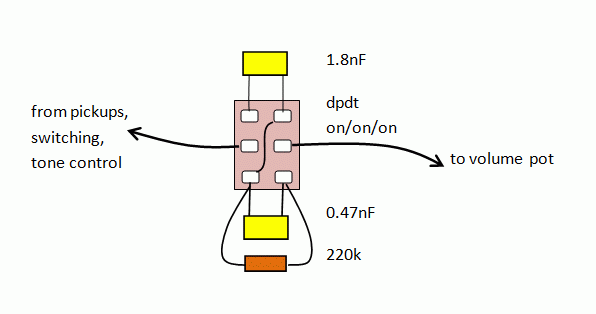 It goes between pickups/switches/tone control, and the volume pot. Its based on two standard 500k pots for tone and volume. |
|
jhawk
Rookie Solder Flinger

Posts: 7 
Likes: 0
|
Post by jhawk on Jan 26, 2015 4:47:03 GMT -5
You're the best. Many thanks! Here's my full layout...maybe you can give it a quick proofread. I'm wondering about the value for the resistor in parallel with the single coil (if I do use one). I'm also wondering if that resistor would significantly effect the output of the pickup. And last question--is my resistor on the bass cut DPDT going the right direction? Does it matter?  |
|
|
|
Post by newey on Jan 26, 2015 5:46:36 GMT -5
Doesn't matter- resistors are bi-directional. Also, your diagram looks fine.
|
|
|
|
Post by JohnH on Jan 26, 2015 7:06:51 GMT -5
I agree the diagram looks fine.
For your load resistor on your single, if you wanted to match the tone as if it was feeding 250k pots, you would use a 270k. Personal, I would not add that resistor. The effect is the same as turning the tone down a tad and the option of clearer tone is good to have.
With all of the values in this design, it is a personal choice and you might like to find the values that work best for you, which could be a step or two different.
Good luck and keep us posted!
|
|
jhawk
Rookie Solder Flinger

Posts: 7 
Likes: 0
|
Post by jhawk on Jan 26, 2015 13:57:31 GMT -5
Thanks for all your help! The guitar probably won't be finished til summertime, but I'll report back with pics and a video.
|
|
nikogo
Meter Reader 1st Class
   Passerby
Passerby
Posts: 51 
Likes: 0
|
Post by nikogo on Feb 21, 2015 16:41:34 GMT -5
I had good enough results with cutting bass tone by bleeding it through an inductance coil (about 2mH).
If in initial schematics we add to the VR3 - C2 branch a similar parallel branch with a coil instead of capacitor and remove all the rest, than the capacitor branch will bleed treble and the coil branch will bleed bass. But for efficient tone control I would use the 30K to 50K pots with switches that disconnect in 0 position corresponding branches from hot/signal line.
The 24V signal relay coil would do the job. I used a coil from the Phoenix Contact #2961105 relay. The Omron G5V signal relays have lower impedance and are better for single coil pickups.
For high output (and impedance) humbuckers may be needed to have two coils connected in series because one coil may cut too much bass.
|
|
|
|
Post by JohnH on Feb 22, 2015 1:25:45 GMT -5
Hi nikogo - welcome to GN2 and thankyou for your interest.
It would be interesting to measure the inductance of those coils. 2mH is a very low value to be used as part of a guitar tone control system (impedance would only be about 13Ohms at 1000 hz), maybe they were more?.
|
|
nikogo
Meter Reader 1st Class
   Passerby
Passerby
Posts: 51 
Likes: 0
|
Post by nikogo on Feb 22, 2015 9:56:25 GMT -5
Hello John,
Yes, you are right, the value is wrong. I was keeping that number in my memory for years without remeasuring (no proper meter around) and it faded.
It is possible that there is about 2H. That coil with capacitor 0.5uF has resonant frequency under 200Hz.
I use such coils with capacitors 0.1 to 0.5 uF to make mid-cut filters.
|
|
george
Rookie Solder Flinger

Posts: 6
Likes: 0
|
Post by george on Jun 30, 2015 11:48:31 GMT -5
Hi!
I'm new to this board, found it on Google when I was searching on the terms "PTB tone control". I tried to download the 2003 version of the Excel file but my Firefox popped up a window saying that your site want to make a LAN connection to my PC, since my Firefox is configured to deny it for security reasons, I opted to do the same, therefore I wasn't able to download the spreadsheet. Would it be possible for me to get it through email?
Anyway, I've got a 2005 Strat deluxe with the S1 switch and noiseless pickups and recently i read so many good posts about making the two tone control pots of regular strats useful that I'm playing with the idea of adding a PTB tone control circuit to my Deluxe strat but so far I haven't found any site or forum where they discuss the PTB in connection with the S1 switch and the noiseless pickups that for sure have different specs than the regular single coil pickups.
George
|
|
|
|
Post by JohnH on Jun 30, 2015 15:28:00 GMT -5
Hi George. I haven't come across that downloading problem before, but Id be happy to email the spreadsheet - just send me a PM.
I cant see any basic problem adding PTB to a Deluxe Strat. The key thing is that there is one master volume pot and you put the PTB system behind that as it is usually, then all the switching is behind that.
But finding the right specs for your noiseless pickups may be difficult. You can measure resistance but inductance would need some research. Even more important is the value of the volume pot, do you know it? I have heard that some of these use very high values. That will be important for picking values that are most likely to work well with PTB, and then it will be down to testing it so Id suggest you plan some temporary way to test what might happen before committing.
If you don't know your pickup and volume pot resistance values, you can test them with a multimeter and you don't need to open the guitar to do it. Its very easy, let me know if you wan to try it.
|
|
|
|
Post by sumgai on Jul 1, 2015 1:03:11 GMT -5
John, For a Strat (Deluxe), the Bridge-mounted SCn pickups are rated at 11.6KΩ of DC resistance, and 3.8H inductance. The Mid and Neck units come in at 6.5KΩ and 2.4H... or so I'm led to believe.  HTH sumgai |
|
george
Rookie Solder Flinger

Posts: 6
Likes: 0
|
Post by george on Jul 1, 2015 6:03:32 GMT -5
Hi John, I changed my profile on this forum, so you or any other member can see my email address. I put all the specs and manuals related to my deluxe Strat, that I managed to get right after I purchased my gear in this folder: tinyurl.com/pqof4fkBy looking at the parts list it looks like all three pots are 250k. But by looking at the switch patterns I realized that this config requires a modified excel file but I could be wrong. Based on the specs of my strat (that I received from the Fender support team in 2006), I have the configuration that is called 3S upgrade, where in the middle position of the 5 pole switch only the middle pickup is engaged. So, it would be quite interesting to see the Excel curves of all these goodies under the hood, I've never really experimented with it too much, I use my Strat mostly with the S1 switch not pushed in. Back in the first couple of years I was into some mods on this strat but someone on a forum told me, don't mess with it, it is good as it is. But since I like to play Shadows tunes a lot, half of them with the early Shadows sound, I was thinking that based on what I read about the PTB tone control, that is the range that might interest me more since it allows to reduce the bass and treble leaving the mid range intact and actually that's what early Shadows sound is about. Sumgai, thanks for the specs on the pickups!! George |
|
|
|
Post by JohnH on Jul 1, 2015 7:49:11 GMT -5
Hi George - I have sent the GF files.
It seems you have all 250k pots, so I think the PTB will work fine. One of your pots is listed as no-load, and if so, that is ideal for the treble cut pot. You can use the other as the bass cut, and it looks like you might get about -6 or -7db of cut available with a 250k pot. If you use a 1M pot, you'll get up to -10 or -11db cut. Try different caps too.
cheers
john
|
|









 ) through the capacitor in parallel with whatever else hangs off the end (V pot, cable, amp input) is the "bottom resistor". For high frequencies, the Z of the pickup gets very large compared to the parallelization of all those other things. All of the voltage is dropped across the pickup winding itself, leaving little to be sensed at the amp. I think the reason that the cap doesn't matter at the top half of the knob is that the rheostat is enough bigger than the cap at a given frequency.
) through the capacitor in parallel with whatever else hangs off the end (V pot, cable, amp input) is the "bottom resistor". For high frequencies, the Z of the pickup gets very large compared to the parallelization of all those other things. All of the voltage is dropped across the pickup winding itself, leaving little to be sensed at the amp. I think the reason that the cap doesn't matter at the top half of the knob is that the rheostat is enough bigger than the cap at a given frequency.





